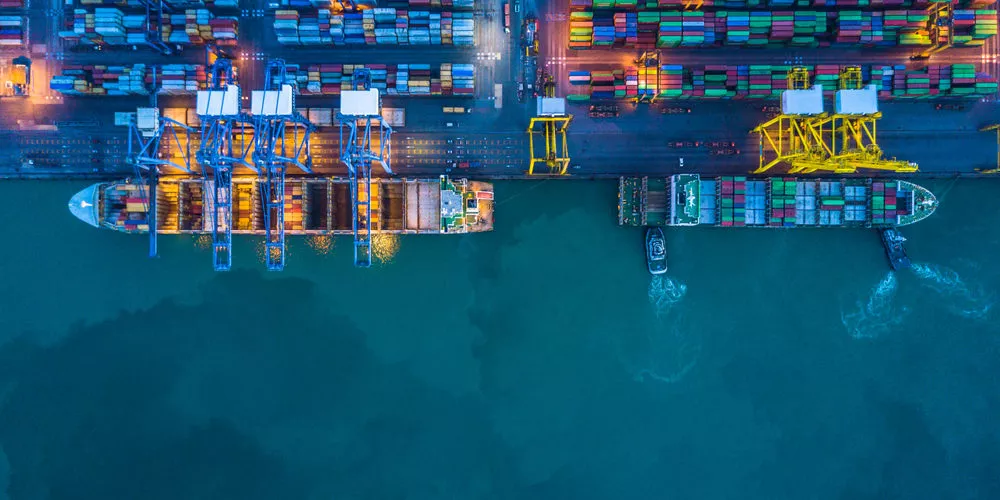Have you ever wondered exactly how your freight gets from the port to the warehouse? In the age of global sourcing, fuel, manufacturing widgets, furniture, clothing, and even food are traded all over the world. You may have heard that vehicle components cross a border eight times during its assembly process. And that doesn’t even account for sourcing outside of North America!
These days, just about everyone is painfully aware of how much cargo is getting moved. Stories about the supply chain’s woes piled up in 2021 almost as quickly as shipping containers waiting to move inland. In the midst of the chaos, we thought it would be interesting to chronicle the journey that these items make from a port to its inland destination.
So, what does that process actually look like?
GETTING TO THE PORT
In order to track a container’s voyage from port to warehouse, we have to start a little further back. Imported products arrive either via a ship or an airplane (in logistics jargon, this is known as different modes). There are pros and cons to using each one.
OCEAN
In ocean shipping, freight gets stacked onto a container ship and ferried across a busy highway of shipping lanes. It’s the most commonly used mode – according to the International Maritime Office, over 90% of cargo gets moved over the ocean, and with good reason. Moving freight via an ocean container tends to be cheap relative to other options, and there are few size or weight limits on the items that can be shipped. The downside? Transit time can be slooooow. We’re talking six weeks or more just to get cargo to the destination port. And that doesn’t account for time spent unloading or getting through customs.
AIR
Shippers who don’t have six weeks to wait might decide to use air freight delivery services. Employing this mode, they move freight either in an airplane that’s built specifically for cargo, or more frequently, in the belly of a commercial plane. This method is fast and reliable, but usually has a much heftier price tag than ocean shipping. It probably won’t come as a surprise that airfreight is often used to ship small, high value items with a short shelf life (think: pharmaceuticals or high value electronic parts).
PORT TO WAREHOUSE: UNLOADING CONTAINERS
Reaching the shore is only the beginning. Modern sea vessels might carry up to 24,000 containers and unloading them takes some doing.
During “normal” times, one might expect the process to take about three business days. Now, in our Covid-induced abnormal season, ships can spend ten days or more anchored off of a coast. After that, it might take more than a week to move containers out of a port.
If you’re wondering why this process has slowed down so much, look no further than the crush of imports that began in mid-2020. The twin ports of Los Angeles and Long Beach handled 17.3 million containers last year, a hair under the previous record of 17.5 million imports in 2018. This year, managers say they are on track to process 20 million units, or a 15.4% increase in traffic. And this prediction predates Black Friday shipping season.
Even the largest ports can only handle so much freight – cranes, longshoremen and equipment are all in limited supply. As containers continue to roll in, and resources stretch thinner, there are only going to be more videos like this one.
PORT TO WAREHOUSE: LAND TRANSPORTATION
Once freight is ready to head inland, it will need to be hauled to its next destination. There are a few ways to do that.
One is to put it on a truck.
As with most aspects of logistics, trucking doesn’t entail a one size fits all approach. Depending on the circumstances, freight may require a dry van, a refrigerated trailer, or a flatbed truck. It can require a whole trailer or only part of one. There are a lot of options!
FULL TRUCKLOAD (FTL)
First, there’s the option to utilize a full truckload, often known in the shipping world as FTL. When a shipper takes this route, they’ve got the whole truck to themselves. Usually, it’s in the form of a 53 foot trailer. Depending on the needs of the cargo inside, the trailer may be refrigerated or have an open deck.
A benefit to utilizing FTL shipping is its speed. A truck filled with one shipper’s cargo won’t have to make extra stops or reassemble freight along the way. This also makes it a great choice for shipments that are fragile or have a tight delivery deadline.
There’s one point to be wary of, though, and that’s price. If you’ve reserved an entire truck, you’ll want to be fairly sure you can fill it, otherwise the cost of that unused space can add up quickly.
LESS-THAN-TRUCKLOAD (LTL)
Another option, when there’s not enough freight to fill a whole truck, is a less-than-truckload, or LTL. In this scenario, shippers share space on a truck and only pay for what they need. The benefits and drawbacks tend to mirror the full truckload. Customers don’t pay for unused space, but delivery time can be slower, thanks to multiple stops en route. Cargo is also likely to get handled more – when multiple shippers share a space, there are more opportunities for loading and unloading freight along the route.
Either way, a truck will haul freight all the way to its destination, whether that’s a warehouse, a distribution center, or a retail store.
Long haul trucking is responsible for nearly 72% of all goods shipped in the United States, according to the Bureau of Transportation Statistics. There’s a reason why this mode is so popular. It’s fast, flexible, and relatively simple. From a shipper’s perspective, there aren’t a lot of moving parts. But it’s not the only method out there.
Sometimes trucking isn’t the answer. For one, rates can fluctuate wildly based on what’s going on in the market. Or sometimes a shipment would require more equipment than a customer is comfortable with.
RAIL
When trucking isn’t the answer, it’s time to turn to rail. With this option, a shipping container is driven a short distance (normally less than 100 miles) to a terminal, before getting placed on a railcar. Once it arrives at its destination, it will be taken on another short-haul to its final stop. Taken together, this is referred to as intermodal shipping because it utilizes multiple transportation modes to complete the journey.
As with every other mode, there are benefits and drawbacks to intermodal shipping. Rail will almost always add a few days to the shipping journey, and it’s harder to pinpoint an exact arrival date. Because it involves more parties, it’s inevitably going to be more complicated (though shippers rarely coordinate every movement).
Where its strength lies is in its fuel efficiency. On average, trains can move one ton of cargo over 450 miles on a single gallon of fuel. The savings add up, especially for long-distance shipments. Rail has even become a preferred transportation method for e-commerce businesses, as they look for ways to offset the increasing cost of last-mile delivery.
TAKE AWAY
Of course, we aren’t here to sell you on one particular shipping mode. There’s obviously a lot to consider when deciding which strategy to use to get your product from port to warehouse. Your best bet can depend on the type and amount of cargo you’re shipping, how quickly you need it, or even the weather.
The good news is that you don’t have to make your transportation decisions alone. WSI works with vendors in every one of these modes. We’ve reliably managed shipments for parcels of all sizes, across every type of carrier. And we maintain visibility for our clients, so that they have final say on important factors like timing and cost. Our experienced team can help you determine the best strategy for you.
Happy shipping!









